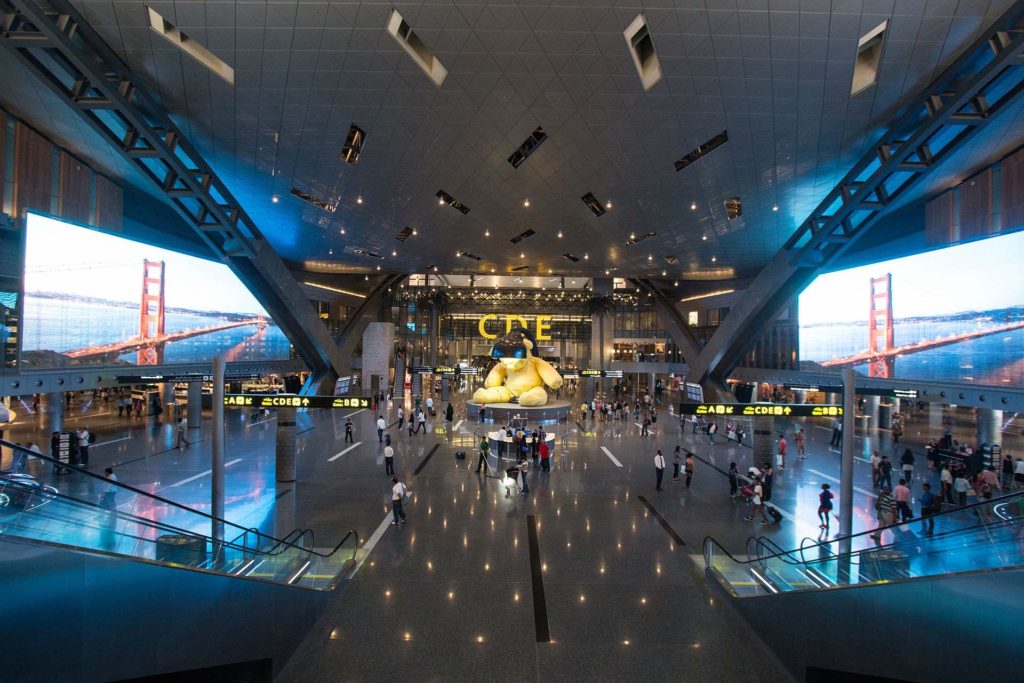Airport architecture has evolved to reflect the culture of our cities—and more energy-efficient design.
With passenger numbers projected to double over the next 20 years, airports are expanding to meet the challenge with sleek new terminals, redesigned for the 21st century. Parks, gardens, movie theaters, spas, even an ice rink and a rooftop pool are among the amenities that can make a dent in that layover.
The ideal airport was once a place where curbside drop-off was as close to the tarmac as possible, says Curtis Fentress, a veteran architect who has designed 25 airports.
“Now airports are civic spaces,” he says. “As a gateway to a city or country, an airport is an opportunity for expression.“ Geography is often a muse. Fentress points to the Denver airport, where his firm’s tented roof mirrors the city’s mountainous backdrop. In Los Angeles, the coastal setting inspired the roof of LAX, imagined as a series of cresting waves.
For Seoul’s Incheon airport, Fentress spent weeks photographing the city’s historic and cultural sites and perusing markets, looking at traditional patterns and construction. His vision for Incheon’s structure was a modern riff on Korean temple design.
From our partners:
Korean-style gardens and local granite and steel were used in the space, and floors sourced from native wood. “We relate the building as much as possible to the place,” Fentress says. As for the user experience, Incheon consistently gets top marks from passengers for its cultural diversions and top-notch services.
The art of the airport isn’t just about the building. “Food and even music are a part of it,” Fentress says. With reduced services on airlines and the rise of budget carriers, restaurants now feature prominently; regional wines, cuisine, and chains are another way airports impart a sense of the city, he says.
To keep their vast, complex spaces humming, airports can use as much energy as a city of 100,000. Designs now incorporate energy efficiency—particularly in the form of maximizing natural light and using the empty buffer zones around airports as solar “farms”—and other green building principles. See more ways that airports are greening their facilities and how flight itself is becoming more fuel efficient.
Check out Fentress’s designs in Seoul, Denver, and Seattle and seven others in our picks of innovative airports.
10. SEOUL INCHEON INTERNATIONAL

Incheon’s roof lines were designed to reflect the sweeping curves of traditional Korean temples. Inside, passengers find more touchstones for Korean culture, including gardens, performances, and a “street” where they can observe artisans and participate in craft making. Its new Terminal 2, scheduled to open in time for the 2018 Olympics, will optimize natural lighting and ventilation and integrate solar panels—along with adding a koi pond, waterfalls, streams, aviaries, and a sculpture garden.
9. Changi Airport Singapore

Singapore is known for its innovative efforts to weave green space throughout the city. Changi is home to about 500,000 plants, in the form of a tapestry-like wall of 10,000 cascading plants and multiple gardens, including ones devoted to butterflies and orchids. To keep them lush, the airport harvests rainwater and uses recycled “NEWater,” part of the city’s extensive water reclamation effort. Terminal 4, which will open in late 2017, will feature even more gardens and a “boulevard” of trees.
8. SEATTLE-TACOMA INTERNATIONAL

Passengers can take in views of the Olympic range though a 350-foot-long glass curtain wall as well as “The Landing” installation, one of Sea-Tac’s many artworks. Tapping unused open space around the airfield, the airport is now home to several honey bee colonies, part of a conservation program aimed at local pollinators.
7. HAMAD INTERNATIONAL – QATAR

Doha has emerged as a global hub, with Qatar Airways growing sixfold in the last decade. Many passengers are expected to descend for World Cup 2022, which launched a building boom that included Hamad. To help battle the desert elements, the walls of the terminal are coated with solar reflective material and special glass controls the intense heat gain and glare.
6. INDIRA GANDHI INTERNATIONAL – DELHI

The Delhi airport is the busiest in India, one of the fastest growing aviation markets, second only to China. Set among hundreds of copper discs, expressive hands—gestures from Indian classical dance and yoga—reach out from a wall. The building’s sustainable features include a northern orientation that reduces sun exposure and more than 300 rainwater harvesting pits.
5. MADRID BARAJAS INTERNATIONAL

Architect Richard Rogers chose bamboo to clad the airport’s interior for its sustainability and warmth. Two million square feet gently curve throughout the vast terminal.
4. BEIJING CAPITAL INTERNATIONAL

Built for the 2008 Olympics—and part of an airport that’s the world’s second busiest—Terminal 3 greets passengers with an imperial-style garden and traditional colors of red and yellow. Energy efficiency is boosted by skylights, whose size and angle work to both warm the building in winter and minimize cooling needs in summer.
3. HEATHROW – LONDON

A planned third runway—and its estimated 260,000 more flights—would bump London’s Heathrow into position as the U.K.’s largest source of carbon emissions. Its Heathrow 2.0 initiative aims to reduce that impact, in part by converting to renewable sources for electricity this year, upgrading to “cleaner” airport vehicles, and restoring the country’s peat bogs—the latter being an offset.
2. CHHATRAPATI SHIVAJI INTERNATIONAL – MUMBAI

Modeled after traditional pavilions and even the tails of peacocks—India’s national bird—a graceful space belies the frenetic pace at this airport in Mumbai, where more than 800 flights take off or land each day. LED lighting and strategically placed skylights reduced energy usage by 23 percent; new measures put organic food waste to practical use.
1. DENVER INTERNATIONAL

The tented roof over Denver’s main terminal reflects its backdrop: the snow-capped Rocky Mountain peaks. Covering 250,000 square feet, the woven fiberglass fabric reflects most sunlight, but still infuses the space with natural light, saving on electricity costs. Sun also powers the airport via its vast fields of solar panels.
This feature originally appeared in National Geographic.
















